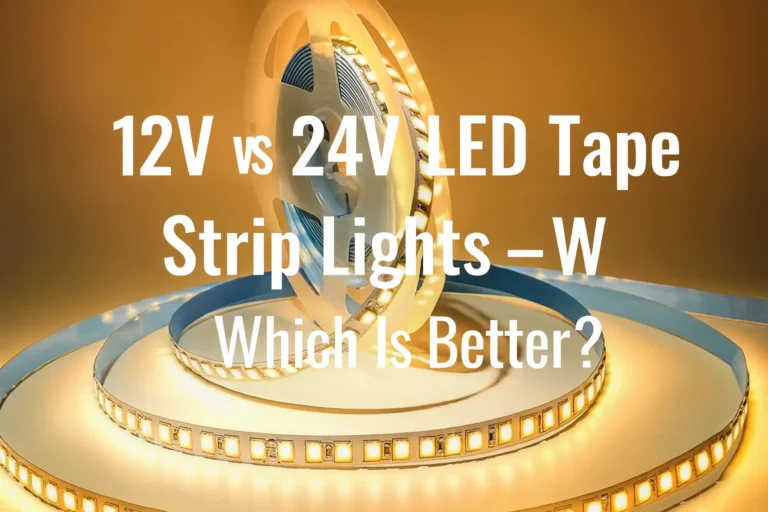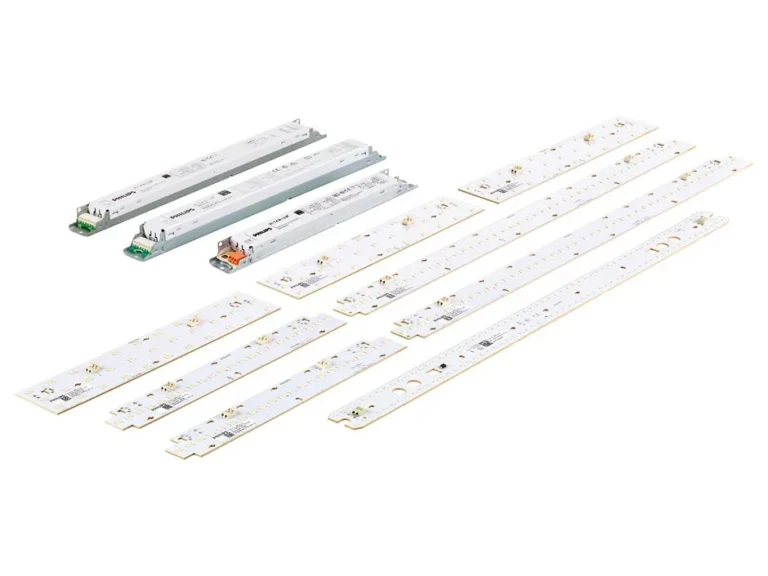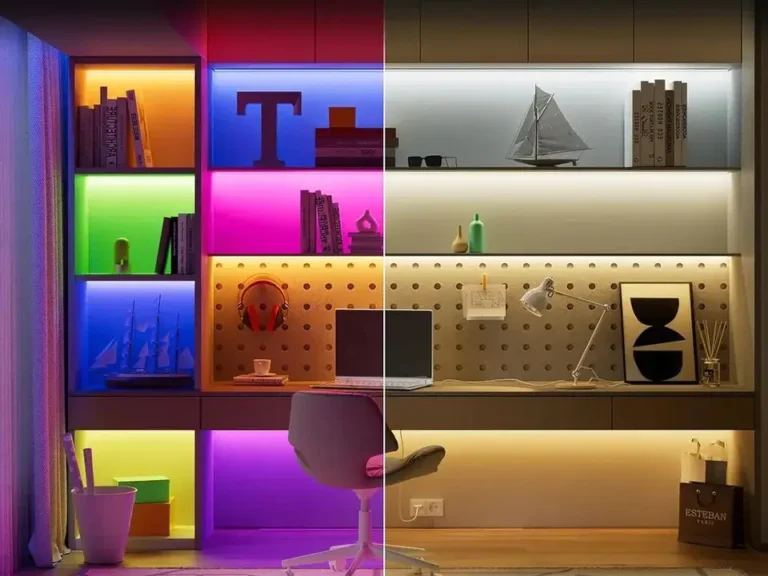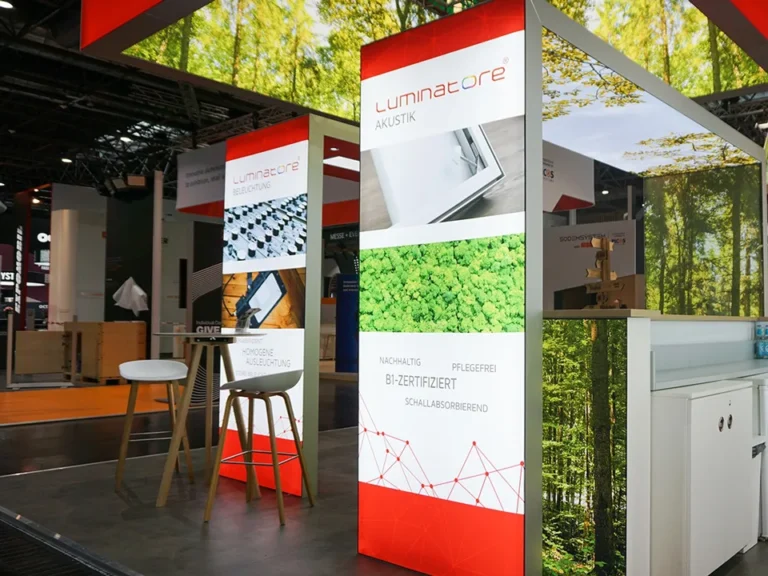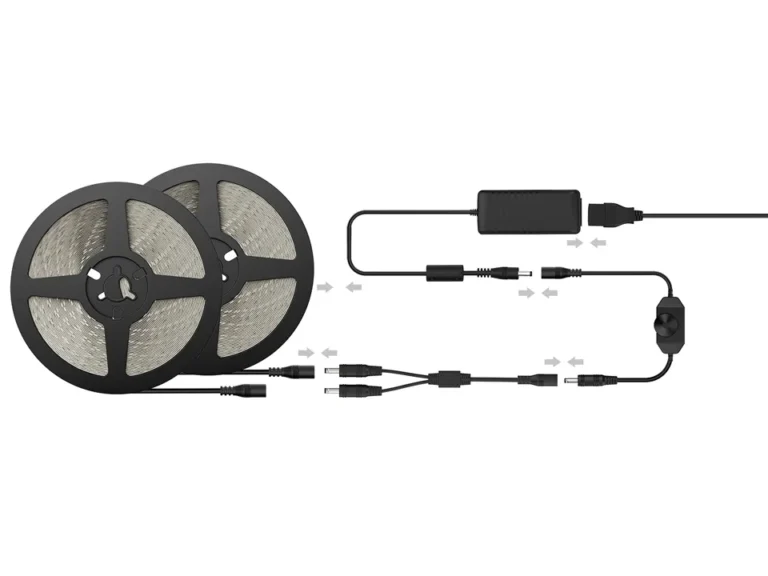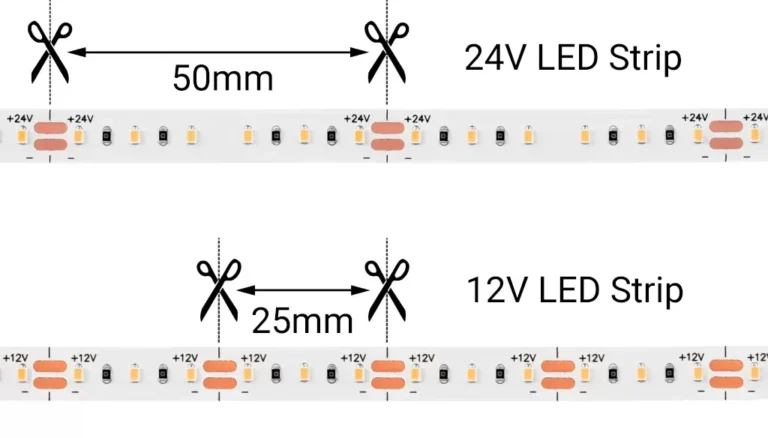introduzione
In Illuminazione a strisce a LED Installazioni, la selezione della tensione è spesso sottovalutata, ma influisce direttamente sulla coerenza della luminosità, sull'efficienza energetica e sui costi di manutenzione a lungo termine. Molti installatori hanno sperimentato situazioni frustranti: strisce LED che si attenuano a metà corsa o frequenti alimentazioni necessarie dopo l'installazione. Nella maggior parte dei casi, questi problemi sono causati dalla scelta del sistema di tensione errato: 12V, 24V o 48V. Per un confronto più profondo tra le due tensioni più comuni, consulta la nostra guida completa: Striscia a LED 12V vs 24V – Come scegliere.
La scelta della giusta tensione della striscia LED è fondamentale per prevenire la caduta di tensione, una perdita di tensione che si verifica quando la corrente elettrica viaggia attraverso la striscia, causando luminosità irregolare e spreco di energia. I sistemi a tensione più alta riducono la corrente per la stessa potenza in uscita, che riduce al minimo la caduta di tensione e l'accumulo di calore, in particolare su lunghi percorsi.
Ad esempio, le strisce LED da 12 V offrono un'elevata flessibilità e sono ideali per progetti fai-da-te a breve termine; le strisce LED da 24 V raggiungono un grande equilibrio tra prestazioni e costi per le corse di media lunghezza; mentre le strisce LED da 48 V eccellono in installazioni a lunga distanza e progetti di ingegneria su larga scala. Questa guida analizzerà le basi della tensione, le differenze di prestazioni e gli scenari di utilizzo migliore, aiutandoti a scegliere la giusta tensione di striscia LED per qualsiasi progetto di illuminazione con sicurezza.

comprensione della tensione della striscia LED
Quando si seleziona la tensione della striscia LED, è importante comprendere la relazione tra tensione e lunghezza massima per le luci a strisce a LED.
Per le strisce LED a tensione costante, una tensione più alta significa che è necessaria una minore corrente per fornire la stessa potenza, che aiuta a ridurre la caduta di tensione e mantenere una luminosità costante su tutta la lunghezza della striscia.
Specifiche tipiche:
Strisce LED 12V: mantenere una luminosità stabile fino a circa 5 metri (16 piedi); oltre questa lunghezza, può verificarsi un'ampiezza evidente.
Strisce LED 24V: Sostenete comunemente corse di circa 10 metri (33 piedi), con alcune opzioni di alta qualità che raggiungono fino a 15 metri.
Strisce LED 48V: può correre da 15 a 20 metri (50–65 piedi) o più; se abbinato a un sistema di strisce LED a corrente costante, sono ottenibili lunghezze di 30–40 metri (100–130 piedi) o più lunghe.
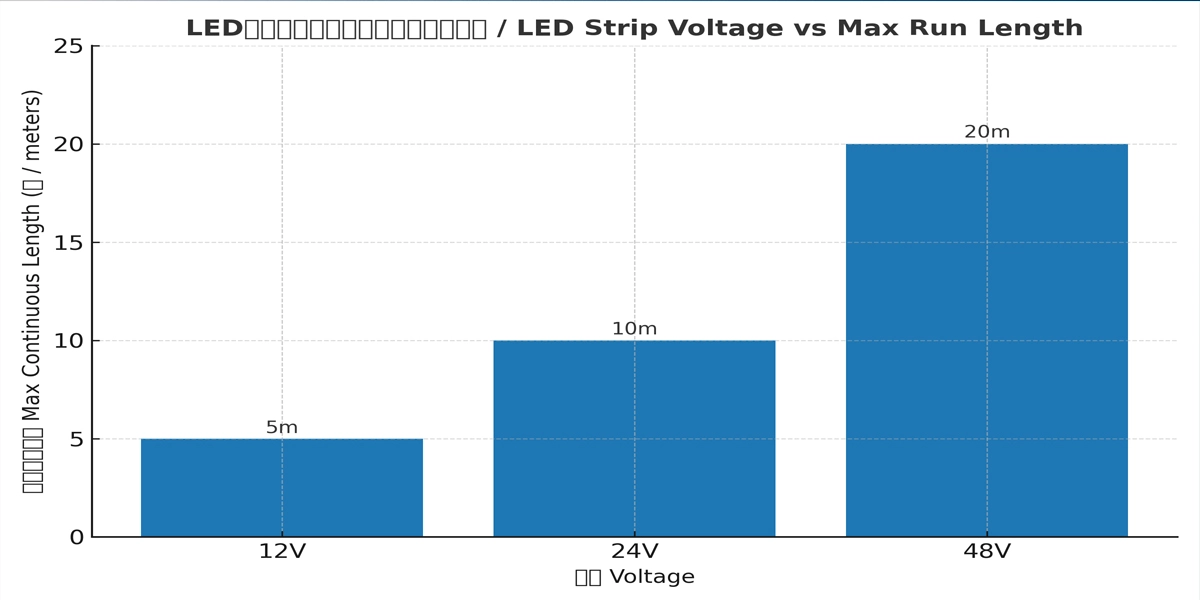
Un altro concetto chiave è la tensione costante rispetto alla corrente costante:
Le strisce LED a tensione costante (come 12V, 24V, 48V) utilizzano un alimentatore a tensione fissa e sono semplici da installare e controllare, ma sono più soggette a caduta di tensione su lunghe distanze.
Le strisce LED a corrente costante forniscono un'emissione di corrente stabile, garantendo luminosità e temperatura del colore uniformi su lunghezze estese, ideali per progetti su larga scala che richiedono prestazioni e coerenza massime.
Comprendendo questi fondamentali, puoi scegliere la corretta tensione della striscia LED che bilancia la lunghezza dell'installazione, la coerenza della luminosità, la complessità del cablaggio e i costi complessivi, garantendo sia l'efficienza che la qualità visiva.
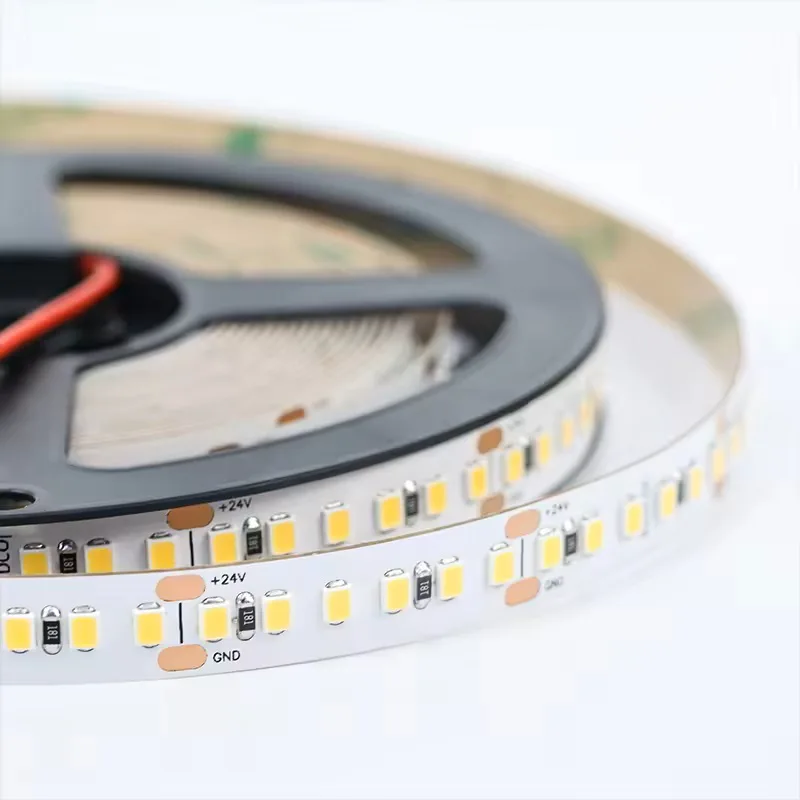
Striscia luminosa SMD2835 LED
Modello principale: FQX08T120C
LED Q.tà per metro Opzione: 60/72/120/128/140
Opzione larghezza PCB: 6 mm/8 mm/10 mm
Opzione colore: 2700K/3000K/4000K/5000K/6500K
Opzione CRI: 80/90
Tensione di ingresso: DC12V/DC24V
Potenza al metro: 6W/8W/9.6W/12W/14.4W/19.2W
Efficienza: 100-200 lumen/watt
Opzione grado IP: IP20/IP54/IP65/IP67/IP68
Garanzia: 5 anni
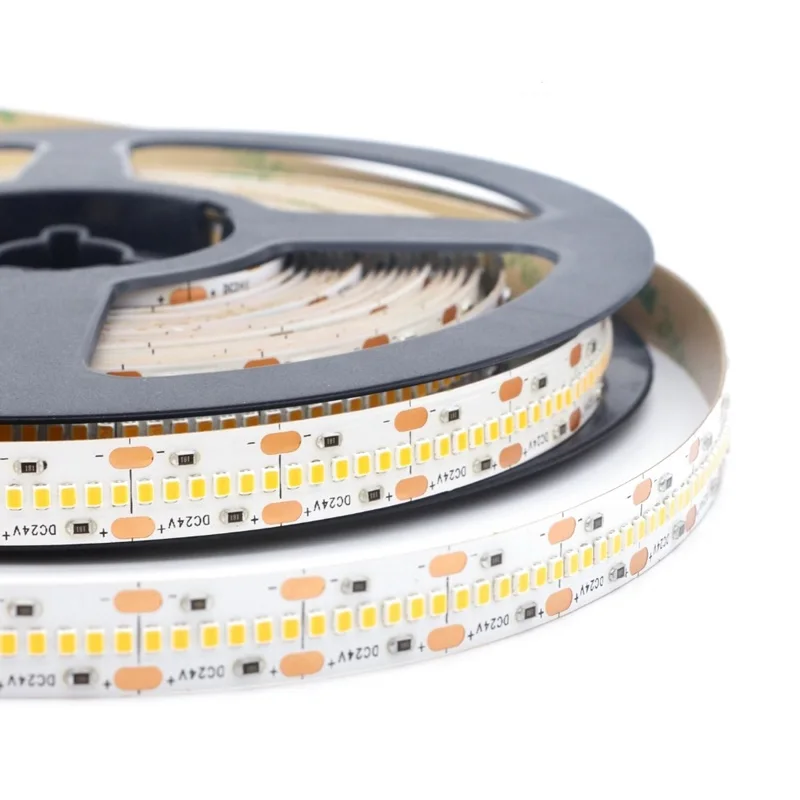
Striscia luminosa LED SMD2216
Modello principale: FWX10T240C
LED Q.tà per metro Opzione: 120/180/240/300/420
Opzione larghezza PCB: 5 mm/10 mm
Opzione colore: 2700K/3000K/4000K/5000K/6500K
Opzione CRI: 80/90
Tensione di ingresso: DC12V/DC24V
Potenza al metro: 9.6W/10W/14.4W/19.2W/20W/24W
Opzione grado IP: IP20/IP54/IP65/IP67/IP68
Garanzia: 5 anni

Striscia LED a corrente costante e a lunga durata
Modello principale: FQX10T120D
Opzione metro per rotolo: 10m/20m/30m/50m
Opzione larghezza PCB: 10 mm/12 mm
Opzione colore: 2700K/3000K/4000K/5000K/6500K
Opzione CRI: 80/90
Tensione di ingresso: DC24V/DC36V/DC48V
Potenza al metro: 4,2W/7,2W/8,5W/12W
Opzione grado IP: IP20/IP54/IP65/IP67/IP68
Garanzia: 5 anni
Quando scegliere luci a strisce a LED da 12 V, 24 V o 48 V
Luci a strisce LED 12V
Le luci a strisce a LED da 12 V funzionano a una tensione inferiore, il che significa una corrente più alta per la stessa potenza. Questo design consente intervalli di taglio più brevi, in genere 25–50 mm, rendendoli perfetti per installazioni dettagliate come scaffali espositivi, accenti di mobili e interni automobilistici.
Tuttavia, poiché i sistemi a bassa tensione sono più soggetti a caduta di tensione, i percorsi più lunghi di 5 m senza iniezione di potenza possono portare a una notevole perdita di luminosità. Ciò è dovuto alla resistenza nei conduttori e nel cablaggio della striscia, una limitazione più pronunciata nei sistemi 12V rispetto a quelli a 24V o 48V.

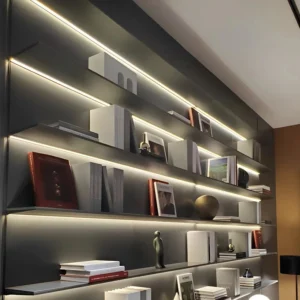
Ideale per:
Corre brevi fino a 5 m senza perdita di luminosità visibile
Illuminazione decorativa e d'accento in mobili, scaffali e piccoli spazi
Sistemi automobilistici, marini, camper e solari
Pro:
- Driver e dimmer ampiamente disponibili a basso costo iniziale e ampiamente disponibili
- Installazione flessibile grazie a brevi intervalli di taglio
- Forte compatibilità con sistemi a batteria a 12V
Contro:
- Caduta di tensione notevole su corse più lunghe senza iniezione di potenza
- Efficienza inferiore rispetto ai sistemi a elevata tensione per lunghe distanze
24V luci a LED
Le luci a strip a LED a 24V raddoppiano la tensione dei sistemi a 12V, dimezzando la corrente per la stessa potenza. Ciò riduce l'accumulo di calore e la caduta di tensione, consentendo corse fino a 10 m senza perdita di luminosità.
La tensione più alta significa una migliore efficienza e un'illuminazione più stabile per applicazioni come l'illuminazione dell'hotel, gli scaffali al dettaglio e l'illuminazione d'accento per ufficio. Mentre gli intervalli di taglio sono in genere più lunghi (50–100 mm), limitando il taglio ultra preciso, l'equilibrio generale tra efficienza, costo e stabilità della luminosità rende 24V la scelta preferita per molti progetti commerciali.
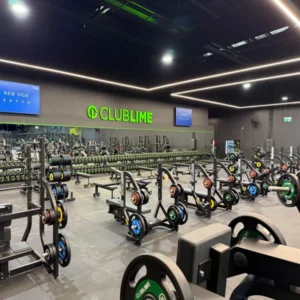
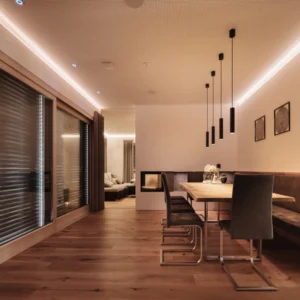
Ideale per:
Installazioni di media lunghezza intorno ai 10 m
Illuminazione commerciale in hotel, uffici e espositori per scaffali al dettaglio
Spazi che richiedono luminosità costante e prestazioni di regolazione fluide
Pro:
- La corrente più bassa riduce il calore e migliora l'efficienza rispetto alle corse medie
- Rapporto costo-prestazioni bilanciato per la maggior parte delle applicazioni commerciali
- Ampia compatibilità con driver di livello professionale e controller DMX/DALI
Contro:
- Intervalli di taglio più grandi riducono la flessibilità nelle installazioni aderenti
- Costo iniziale leggermente superiore rispetto ai sistemi a 12V
Luci a strisce LED 48V
Le luci a strip a LED da 48 V offrono il flusso di corrente più basso per la stessa potenza, riducendo drasticamente la caduta di tensione anche su distanze di 15–20 m o più. Ciò consente una luminosità uniforme su installazioni su larga scala come facciate degli edifici, lunghe calette o caratteristiche architettoniche all'aperto senza frequenti punti di iniezione di potenza.
La ridotta complessità del cablaggio e il minor numero di alimentatori riducono i costi di installazione e manutenzione. Tuttavia, gli intervalli di taglio sono i più lunghi (100–200 mm), limitando l'uso nei progetti che richiedono un adattamento di precisione. Inoltre, i driver compatibili e i sistemi di dimmer sono meno comuni rispetto alle opzioni a 12V e 24V.
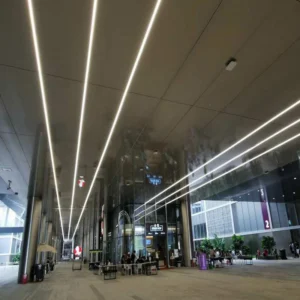
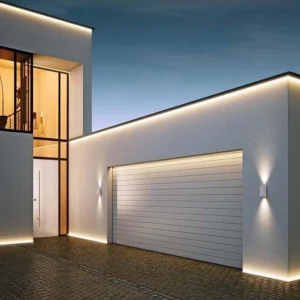
Ideale per:
Installazioni a lunga distanza di 15-20 m o più
Illuminazione architettonica per facciate, calette a soffitto e grandi progetti all'aperto
Progetti commerciali o di ingegneria che mirano a ridurre al minimo il cablaggio e l'alimentazione elettrica
Pro:
- Corrente più bassa tra le tre tensioni, offrendo la luminosità più stabile
- Alta efficienza energetica su lunghe distanze
- Meno alimentatori necessari, riducendo la complessità e la manutenzione del cablaggio
Contro:
- Disponibilità limitata di driver e controller compatibili rispetto a 12V/24V
- Intervalli di taglio lunghi riducono le opzioni di personalizzazione in spazi ristretti
Guida alla selezione della tensione della striscia LED
| Tensione | Meglio per | Lunghezza massima della corsa | Intervallo di taglio tipico | Gamma di potenza comune (W/m) | Pro | Contro |
| 12V | brevi corse ≤ 5 m; illuminazione decorativa; automobili, marine, camper, sistemi solari | ~5 m | 25–50 mm | 4,8–14,4 W/m | Basso costo; brevi intervalli di taglio; alta compatibilità con sistemi a batteria a 12V | Caduta di tensione maggiore su lunghe corse; efficienza inferiore per distanze estese |
| 24V | media corse ~10 m; hotel, uffici, scaffali al dettaglio; dimmerazione costante | ~10 m | 50–100 mm | 7.2–19.2 W/m | Corrente più bassa riduce il calore; buon equilibrio in termini di prestazioni; compatibile con i driver professionali | intervalli di taglio più lunghi di 12 V; costo leggermente superiore |
| 48V | Long run 15–20 m+; facciate architettoniche, grandi progetti all'aperto | 15–20+ m | 100–200 mm | 10–20 W/m | Corrente più bassa, caduta di tensione minima; massima efficienza su lunghe corse; meno alimentatori richiesti | Opzioni di driver/controller limitate; intervalli di taglio più lunghi |
*La lunghezza massima della corsa si basa sull'installazione standard senza iniezione di potenza aggiuntiva.
Errori da evitare quando si sceglie la tensione della striscia LED
La scelta della tensione della striscia LED errata può causare perdita di luminosità, surriscaldamento o rilavorazione costosa. Ecco gli errori più comuni da evitare:
Utilizzo di strisce da 12V per lunghe corse senza iniezione di potenza
Le strisce LED da 12V sono ideali per corse brevi (≤5 m). Usarli per distanze più lunghe senza aggiungere alimentatori extra provoca un calo della luminosità visibile.
Tagliare la striscia nella posizione sbagliata
Che si tratti di 12V, 24V o 48V, tagliano sempre i pad in rame designati. Tagliare altrove può danneggiare il circuito e rendere inutilizzabile la striscia.
Corrispondenza alla tensione di alimentazione sbagliata
Non collegare mai una striscia da 12 V a un alimentatore a 24 V o 48 V (o viceversa). Questo può bruciare istantaneamente i LED.
Scopri di più sul perché le tensioni non corrispondenti possono danneggiare i tuoi LED nella nostra guida dettagliata: Collegamento di strisce LED da 12 V in un alimentatore a 24 V.
ignorando i calcoli della caduta di tensione
Per percorsi superiori a 5 m (12V), 10 m (24V) o 20 m (48V), calcolare in anticipo la caduta di tensione e pianificare l'iniezione di potenza o i sistemi a tensione superiore.
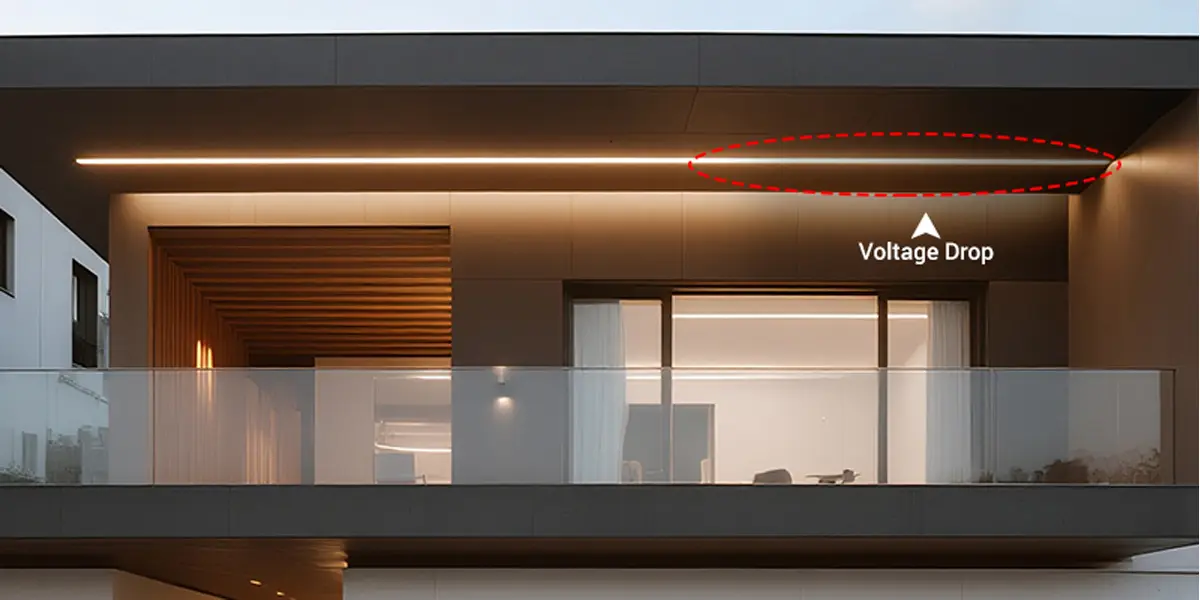
Sovraccarico dell'alimentatore
Scegli sempre un driver con almeno 20–30% in più di capacità rispetto al wattaggio totale delle tue strisce LED.
FAQ – Selezione della tensione della striscia LED
no . L'alimentazione di una tensione superiore a quella della striscia è classificata per sovrascrivere i LED, causando surriscaldamento, danni o guasti istantanei. Abbina sempre la tensione della striscia con la tensione di alimentazione.
Per la maggior parte delle installazioni all'aperto, sono preferite strisce LED da 24 o 48 V perché consentono corse più lunghe con minori perdite di tensione, il che è importante per l'illuminazione architettonica o di facciata su larga scala.
12V: fino a 5 m senza iniezione di potenza
24V: fino a 10 m senza iniezione di potenza
48V: fino a 15–20 m senza iniezione di potenza
I cicli più lunghi richiedono alimentatori aggiuntivi o cablaggi paralleli.
Le strisce LED da 12V sono le migliori per le applicazioni automobilistiche, marittime e per camper perché sono direttamente compatibili con i sistemi a batteria a 12V. Se si prevede di collegare più strisce LED da 12 V a un alimentatore, leggere la nostra guida passo passo: Riesci a collegare più strisce LED da 12 V a un alimentatore?
non necessariamente. La luminosità dipende dal tipo di LED, dalla densità (LED al metro) e dalla potenza. La tensione influisce principalmente sulla lunghezza e sull'efficienza della corsa.
Conclusione
La scelta della giusta tensione della striscia LED influisce non solo sui risultati dell'installazione, ma anche sulla coerenza della luminosità, sull'efficienza energetica e sui costi di manutenzione.
Brevi corse e illuminazione di precisione: scegli 12V per un taglio flessibile e la compatibilità con i sistemi a batteria a bassa tensione.
Run medio e spazi commerciali: scegli 24V per un mix equilibrato di prestazioni e costi.
Long Run e progetti su larga scala: opta per 48V per ridurre al minimo la caduta di tensione e semplificare il cablaggio.
Per il miglior risultato, considera la lunghezza della corsa, i requisiti di taglio, la disposizione della potenza e la sicurezza prima di decidere: questo garantisce l'equilibrio ottimale tra prestazioni, costi e manutenzione.
Per stimare l'uso e l'efficienza energetica del tuo progetto, consulta la nostra guida completa: Quanta elettricità usa una striscia LED?

